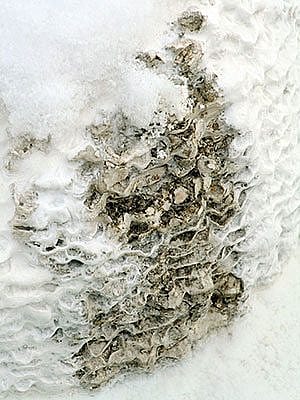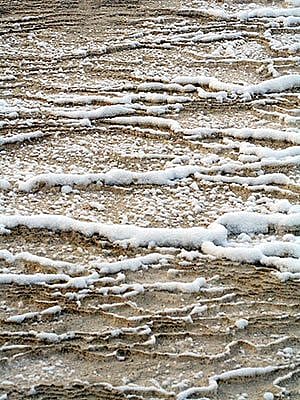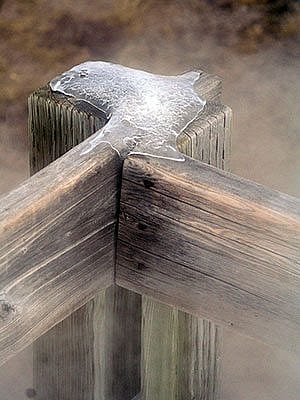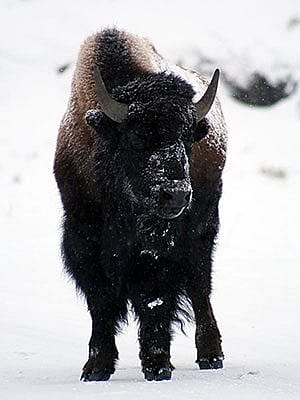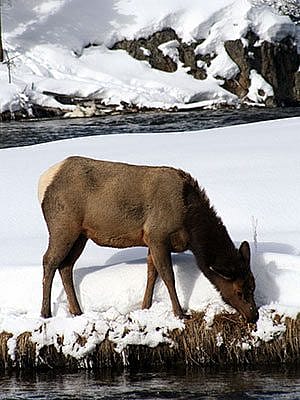
A winter visit to Yellowstone National Park
It’s snowed at least a foot over the past couple days here in Cody, Wyoming. A bit unusual for right here in town—often much of the snow in a storm falls before it gets here, dropping to the west of us as the elevation climbs over the fifty miles between here and Yellowstone National Park. Sure is easy to forget how pretty it actually is when you’re shoveling it!
Winter in Yellowstone
But it can be winter wonderland this time of year, especially for those of us lucky enough to live near Yellowstone. It doesn’t necessarily occur to everyone that the dead of winter is a good time to visit the park, but the three winter trips I’ve made there rank as some of the best winter experiences I’ve ever had. The feeling evoked by immersing yourself in winter in Yellowstone can be hard to explain, but I’ll give it a try.
I’m sure it comes as no surprise that there are crowds in Yellowstone in the summer. Of course there are: it’s beautiful there, it was the nation’s first official national park, there are awesome thermal features and landscapes all over the place, and you stand a good chance of seeing amazing wildlife.
But guess what? All those things are true in the winter too, with the very notable exception of the crowds. There are not crowds of people in the winter. There is a quiet that’s hard to come by in the summer, unless you hike into the backcountry. And those thermal features are, if this is even possible, more impressive with the colder temperatures of winter amplifying the visibility of steam and mist. The moisture settles onto the trees and refreezes into interesting icicles and patterns. I like patterns. They’re fun to photograph.
Getting There
Of course, you have to get to Yellowstone first to see all this. Patience, as they say, is a virtue. From Cody, the shortest route is to go north into Montana to Laurel, then west to Livingston, and then south again to the North Entrance of the park at Gardiner. It’s about a four-hour trip as opposed to summer’s one-hour drive to the East Entrance. Why this longer route, you ask? In the winter season most roads into the park are closed to regular vehicles.
This route north, west, and south again is the one a friend of mine and I took into Yellowstone at the end of January. We booked a package deal with park concessionaire Xanterra—well in advance. (Make note of that; while there are fewer people visiting in the winter, there are also fewer accommodations so planning ahead is essential.) A night’s stay in Mammoth Hot Springs, a snow coach tour to the Old Faithful area—I say “tour” because the drivers of these vehicles on tracks are great guides, talking and answering questions about everything from wildlife to geology to geysers to the park’s colorful history—two nights at Old Faithful with breakfast included, then back to Mammoth for one more night before the long drive home.
At Old Faithful we stayed in a spacious cabin that’s part of the Old Faithful Snow Lodge area. The bell hop zipped our luggage and skis over to the cabin on a snowmobile. It was a very cold weekend, but bundled up properly and moving at a decent pace on foot or on skis kept us warm enough, and in awe of the aforementioned steam and mist. Old Faithful was amazing as expected, although a gray sky behind the steam and water meant photos just couldn’t do it justice.
I’m a cross country skier (admittedly not a very good one—steep hills and sharp curves can trip me up), but others were snowshoeing, and some were hiking just fine on the packed snow on trails and boardwalks. These days, snowmobilers ride cleaner and quieter machines. The snow coaches are fascinating even to the not-so-mechanically inclined—the old and squat bombardiers, newer coaches that resemble comfortable tour buses, and some just a van body on tracks. Everybody respected everyone else regardless of their preferred method of travel, yielding to others when courtesy called for it.
Our first night at Old Faithful we went on an after-dark tour called “Steam, Stars, and Winter Soundscapes.” Amazing. The swath of the Milky Way, constellations, the North Star, all were stunningly visible in a way that only happens without the interference of the bright lights of “civilization.” The sound of the roiling water in Excelsior Geyser is amplified in the dark. And if you’ve never been to Black Sand Pool, make a point to go sometime—summer or winter, night or day. It thumps. Yep, thumps. The best way to experience this is to lie down on the ground by the fence that surrounds the pool. You can feel the thump through your entire body.
Wildlife Sightings
And the Yellowstone wildlife sightings… We saw bison in abundance; with a gentle light snow falling much of the time, they had a sprinkling of white on their backs, and frost around their noses. In the deep snow, they swing their powerful heads back and forth to sweep it out of the way to reach the vegetation they seek underneath. We saw coyotes who looked like they are faring well, with full and healthy-looking coats. A few elk nibbled here and there. Raptors flew over now and then. The beaver we saw was camera shy, but I enjoyed seeing trumpeter swans and signets. I haven’t seen the trumpeters in the summer for a long time. Turns out there are more of them in the winter. Those that summer in Canada winter in Yellowstone where it’s relatively warm—at least, it is to swans from Canada. And my favorite was a fox who was “mousing” in a meadow, jumping up and diving down into the snow hunting a rodent for lunch.
I have loved my experiences in Yellowstone in the winter, and hope at least some readers will consider making plans to follow in my tracks to enjoy the quiet mystique of the park during what we call the “off season.” There are other jumping-off points into the park in winter, too, but I recommend a trip to Cody and the Buffalo Bill Center of the West first, and then taking the scenic route to the winter wonderland of Yellowstone National Park. Trust me, you won’t be disappointed. Oh…and dress warm!
Written By
Nancy McClure
Nancy now does Grants & Foundations Relations for the Center of the West's Development Department, but was formerly the Content Producer for the Center's Public Relations Department, where her work included writing and updating website content, publicizing events, copy editing, working with images, and producing the e-newsletter Western Wire. Her current job is seeking and applying for funding from government grants and private foundations. In her spare time, Nancy enjoys photography, reading, flower gardening, and playing the flute.




